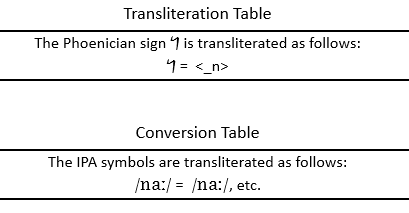3 Phoenician signs seen from the Phoenicians’ perspective
If asked about the nature of their Phoenician signs, a Phoenician would probably explain in non-technical terms that a Phoenician sign had several “sounds”. To illustrate his point, he might read out all the possible “sounds” of a certain sign, say, <_n>. These “sounds” would be transcribed today as /na/, /ni/, /nu/, /na:/, /ni:/, /nu:/, /ne:/, and /no:/. Of these eight “sounds”, three are short and five are long.[1] To write any of these eight “sounds”, he would use the same sign <_n>. When reading the sign <_n> used in actual writing, he would know which of the eight “sounds” it stood for.
The multiple sounds of a Phoenician sign would not pose much of a problem for the Phoenician in reading because he would not read sign by sign, but would take in a group of signs that formed a meaningful unit at one time. He knew which sound of a sign to read in a written word once he understood the meaning of the word from its context. A sign used in actual writing is in fact unlike a sign taken out of its context: the former had only one sound while the latter had multiple ones. Writing Phoenician with Phoenician signs was even easier for a Phoenician. In writing the spoken words in his language, he would break them down into the smallest sounds possible and use a sign for each sound. For any of the eight related “sounds”, he would use the same sign. To write all the possible sounds in Phoenician, he needed only twenty-two signs.
It must be noted that what the Phoenician meant by a “sound” above is, in today’s linguistic parlance, a syllable. To a Phoenician, a syllable was the smallest analysable unit of sound in Phoenician speech (Powell 2009:171). A Phoenician sign, therefore, stood for several related syllables. Today, it can be said that a Phoenician sign stood for a set of CV syllables with a common onset followed by different rhymes. However, this description applies only to a Phoenician sign taken out of its context. In actual writing, it stood for one and only one syllable. Take for example the Phoenician sign <_n>. It stood for /na/, /ni/, /nu/, /na:/, /ni:/, /nu:/, /ne:/, or /no:/ in actual writing. Each of these syllables begins with a common /n/ and ends with a different rhyme. Thus it can rightly be said that <_n> is a syllabic sign, even though it has multiple sound values.
Some linguists hold that in a purely syllabic system a single symbol represents one syllable (Simpson 1994:5055). It might be argued on this ground that strictly speaking a Phoenician sign is not a syllabic sign because it represents several syllables. However, it should be noted that in a segmental writing system like English, it is quite common for a letter to have multiple sound values. Take for example the letter <a>. In the following sentence, each <a> represents a different vowel sound in a British accent called Received Pronunciation: ‘The village school master washed his face and hands.’ That <a> represents multiple sounds does not prevent it from being called a vowel letter.[2] By the same token, that a Phoenician sign represents several syllables should not prevent it from being called a syllabic sign either. As can be seen from the English sentence above, the presence of a sign with multiple sound values does not affect the normal operation of a writing system. It is in fact quite common for a sign to have multiple sound values in many writing systems.
Many linguists think that a Phoenician sign represents the consonantal value of a syllable while ignoring the vocalic element (Olson 2003:1028). If a modern linguist were to explain this view to a Phoenician, the Phoenician would not understand what he or she said at first. It would take the linguist a long time to make the Phoenician understand that the sounds of a Phoenician sign, say, <_n>, could be written as NA, NĀ, NI, NĪ, NU, NŪ, NĒ, and NŌ, and that the letter N denotes an unvarying consonant whereas the other letters denote different vowels. The linguist might say that the Phoenician <_n> sign could be regarded as the letter N, which denotes a consonant only without indicating a vowel. The Phoenician would probably think this way of looking at the Phoenician signs unnecessarily complicated because their writing did not operate in this way. The multiple sounds of a Phoenician sign did not affect in any important way how they used the sign in writing and in reading.
[1] The three short “sounds” /na/, /ni/, and /nu/ are basic. The five long “sounds” are derived from the three basic “sounds” mainly as follows: /na/+/Ɂa/ ˃/na:/; /ni/+/ji/ ˃/ni:/; /nu/+/wu/ ˃/nu:/; /na/+/ji/ ˃/nai/˃/ne:/; /na/+/wu/ ˃/nau/˃/no:/.
[2] A vowel or consonant sound will be referred to simply as a vowel or consonant in this treatise, while a vowel or consonant letter will always be referred to as a vowel or consonant letter, not simply as a vowel or consonant.

25 December 2016
Views: 494